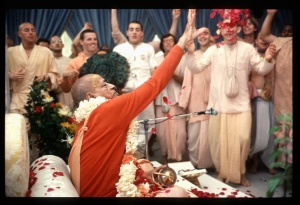CC Adi 5.71: Difference between revisions
m (1 revision(s)) |
(Vanibot #0054 edit - transform synonyms into clickable links, which search similar occurrences) |
||
| (One intermediate revision by one other user not shown) | |||
| Line 1: | Line 1: | ||
{{ | [[Category:Sri Caitanya-caritamrta - Adi-lila Chapter 05|C071]] | ||
<div style="float:left">'''[[Sri Caitanya-caritamrta|Śrī Caitanya-caritāmṛta]] - [[CC Adi|Ādi-līlā]] - [[CC Adi 5|Chapter 5: The Glories Of Lord Nityānanda Balarāma]]'''</div> | |||
<div style="float:right">[[File:Go-previous.png|link=CC Adi 5.70|Ādi-līlā 5.70]] '''[[CC Adi 5.70|Ādi-līlā 5.70]] - [[CC Adi 5.72|Ādi-līlā 5.72]]''' [[File:Go-next.png|link=CC Adi 5.72|Ādi-līlā 5.72]]</div> | |||
{{CompareVersions|CC|Adi 5.71|CC 1975|CC 1996}} | |||
{{RandomImage}} | |||
==== TEXT 71 ==== | ==== TEXT 71 ==== | ||
<div | <div class="verse"> | ||
yasyaika-niśvasita-kālam athāvalambya | :yasyaika-niśvasita-kālam athāvalambya | ||
jīvanti loma-vila-jā jagad-aṇḍa-nāthāḥ | :jīvanti loma-vila-jā jagad-aṇḍa-nāthāḥ | ||
viṣṇur mahān sa iha yasya kalā-viśeṣo | :viṣṇur mahān sa iha yasya kalā-viśeṣo | ||
govindam ādi-puruṣaṁ tam ahaṁ bhajāmi | :govindam ādi-puruṣaṁ tam ahaṁ bhajāmi | ||
</div> | </div> | ||
| Line 14: | Line 18: | ||
==== SYNONYMS ==== | ==== SYNONYMS ==== | ||
<div | <div class="synonyms"> | ||
''[//vanipedia.org/wiki/Special:VaniSearch?s=yasya&tab=syno_o&ds=1 yasya]'' — whose; ''[//vanipedia.org/wiki/Special:VaniSearch?s=eka&tab=syno_o&ds=1 eka]'' — one; ''[//vanipedia.org/wiki/Special:VaniSearch?s=niśvasita&tab=syno_o&ds=1 niśvasita]'' — of breath; ''[//vanipedia.org/wiki/Special:VaniSearch?s=kālam&tab=syno_o&ds=1 kālam]'' — time; ''[//vanipedia.org/wiki/Special:VaniSearch?s=atha&tab=syno_o&ds=1 atha]'' — thus; ''[//vanipedia.org/wiki/Special:VaniSearch?s=avalambya&tab=syno_o&ds=1 avalambya]'' — taking shelter of; ''[//vanipedia.org/wiki/Special:VaniSearch?s=jīvanti&tab=syno_o&ds=1 jīvanti]'' — live; ''[//vanipedia.org/wiki/Special:VaniSearch?s=loma&tab=syno_o&ds=1 loma]-[//vanipedia.org/wiki/Special:VaniSearch?s=vila&tab=syno_o&ds=1 vila]-[//vanipedia.org/wiki/Special:VaniSearch?s=jāḥ&tab=syno_o&ds=1 jāḥ]'' — grown from the hair holes; ''[//vanipedia.org/wiki/Special:VaniSearch?s=jagat&tab=syno_o&ds=1 jagat]-[//vanipedia.org/wiki/Special:VaniSearch?s=aṇḍa&tab=syno_o&ds=1 aṇḍa]-[//vanipedia.org/wiki/Special:VaniSearch?s=nāthāḥ&tab=syno_o&ds=1 nāthāḥ]'' — the masters of the universes (the Brahmās); ''[//vanipedia.org/wiki/Special:VaniSearch?s=viṣṇuḥ&tab=syno_o&ds=1 viṣṇuḥ] [//vanipedia.org/wiki/Special:VaniSearch?s=mahān&tab=syno_o&ds=1 mahān]'' — the Supreme Lord, Mahā-Viṣṇu; ''[//vanipedia.org/wiki/Special:VaniSearch?s=saḥ&tab=syno_o&ds=1 saḥ]'' — that; ''[//vanipedia.org/wiki/Special:VaniSearch?s=iha&tab=syno_o&ds=1 iha]'' — here; ''[//vanipedia.org/wiki/Special:VaniSearch?s=yasya&tab=syno_o&ds=1 yasya]'' — whose; ''[//vanipedia.org/wiki/Special:VaniSearch?s=kalā&tab=syno_o&ds=1 kalā]-[//vanipedia.org/wiki/Special:VaniSearch?s=viśeṣaḥ&tab=syno_o&ds=1 viśeṣaḥ]'' — particular plenary portion or expansion; ''[//vanipedia.org/wiki/Special:VaniSearch?s=govindam&tab=syno_o&ds=1 govindam]'' — Lord Govinda; ''[//vanipedia.org/wiki/Special:VaniSearch?s=ādi&tab=syno_o&ds=1 ādi]-[//vanipedia.org/wiki/Special:VaniSearch?s=puruṣam&tab=syno_o&ds=1 puruṣam]'' — the original person; ''[//vanipedia.org/wiki/Special:VaniSearch?s=tam&tab=syno_o&ds=1 tam]'' — Him; ''[//vanipedia.org/wiki/Special:VaniSearch?s=aham&tab=syno_o&ds=1 aham]'' — I; ''[//vanipedia.org/wiki/Special:VaniSearch?s=bhajāmi&tab=syno_o&ds=1 bhajāmi]'' — worship. | |||
</div> | </div> | ||
| Line 21: | Line 25: | ||
==== TRANSLATION ==== | ==== TRANSLATION ==== | ||
<div | <div class="translation"> | ||
“The Brahmās and other lords of the mundane worlds appear from the pores of Mahā-Viṣṇu and remain alive for the duration of His one exhalation. I adore the primeval Lord, Govinda, of whom Mahā-Viṣṇu is a portion of a plenary portion.” | “The Brahmās and other lords of the mundane worlds appear from the pores of Mahā-Viṣṇu and remain alive for the duration of His one exhalation. I adore the primeval Lord, Govinda, of whom Mahā-Viṣṇu is a portion of a plenary portion.” | ||
</div> | </div> | ||
| Line 28: | Line 32: | ||
==== PURPORT ==== | ==== PURPORT ==== | ||
<div | <div class="purport"> | ||
This description of the Lord’s creative energy is from the Brahma-saṁhitā ( | This description of the Lord’s creative energy is from the ''Brahma-saṁhitā (BS 5.48)'', which Lord Brahmā compiled after his personal realization. When Mahā-Viṣṇu exhales, the spiritual seeds of the universes emanate from Him in the form of molecular particles like those that are visible, three times the size of an atom, when sunlight is diffused through a small hole. In these days of atomic research it will be a worthwhile engagement for atomic scientists to learn from this statement how the entire creation develops from the spiritual atoms emanating from the body of the Lord. | ||
</div> | </div> | ||
__NOTOC__ | |||
<div style="float:right; clear:both;">[[File:Go-previous.png|link=CC Adi 5.70|Ādi-līlā 5.70]] '''[[CC Adi 5.70|Ādi-līlā 5.70]] - [[CC Adi 5.72|Ādi-līlā 5.72]]''' [[File:Go-next.png|link=CC Adi 5.72|Ādi-līlā 5.72]]</div> | |||
__NOTOC__ | |||
__NOEDITSECTION__ | |||
Latest revision as of 19:08, 19 February 2024

A.C. Bhaktivedanta Swami Prabhupada
TEXT 71
- yasyaika-niśvasita-kālam athāvalambya
- jīvanti loma-vila-jā jagad-aṇḍa-nāthāḥ
- viṣṇur mahān sa iha yasya kalā-viśeṣo
- govindam ādi-puruṣaṁ tam ahaṁ bhajāmi
SYNONYMS
yasya — whose; eka — one; niśvasita — of breath; kālam — time; atha — thus; avalambya — taking shelter of; jīvanti — live; loma-vila-jāḥ — grown from the hair holes; jagat-aṇḍa-nāthāḥ — the masters of the universes (the Brahmās); viṣṇuḥ mahān — the Supreme Lord, Mahā-Viṣṇu; saḥ — that; iha — here; yasya — whose; kalā-viśeṣaḥ — particular plenary portion or expansion; govindam — Lord Govinda; ādi-puruṣam — the original person; tam — Him; aham — I; bhajāmi — worship.
TRANSLATION
“The Brahmās and other lords of the mundane worlds appear from the pores of Mahā-Viṣṇu and remain alive for the duration of His one exhalation. I adore the primeval Lord, Govinda, of whom Mahā-Viṣṇu is a portion of a plenary portion.”
PURPORT
This description of the Lord’s creative energy is from the Brahma-saṁhitā (BS 5.48), which Lord Brahmā compiled after his personal realization. When Mahā-Viṣṇu exhales, the spiritual seeds of the universes emanate from Him in the form of molecular particles like those that are visible, three times the size of an atom, when sunlight is diffused through a small hole. In these days of atomic research it will be a worthwhile engagement for atomic scientists to learn from this statement how the entire creation develops from the spiritual atoms emanating from the body of the Lord.